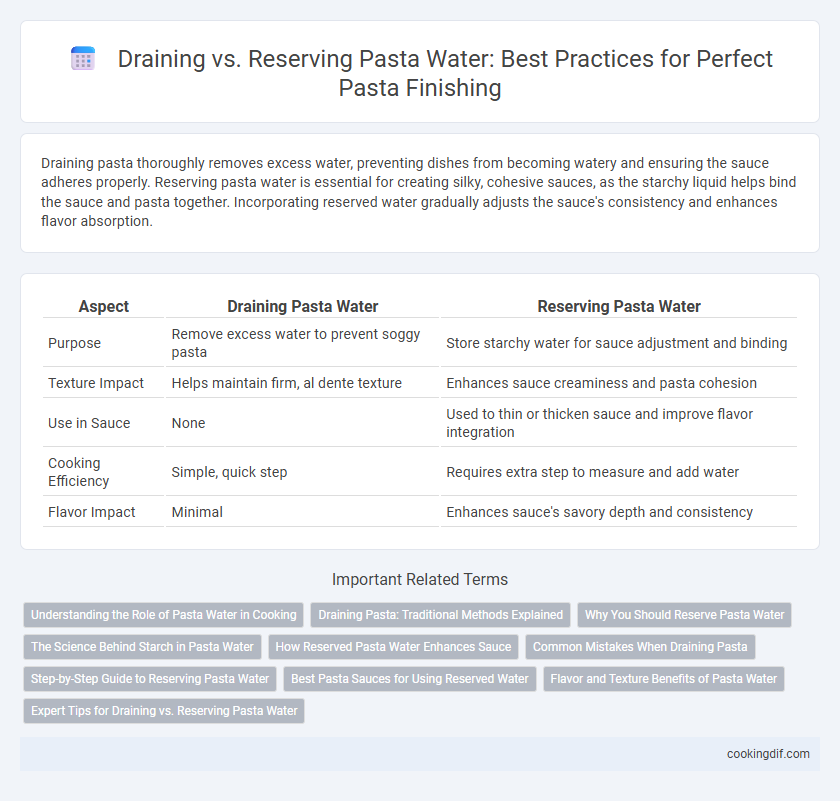Draining pasta thoroughly removes excess water, preventing dishes from becoming watery and ensuring the sauce adheres properly. Reserving pasta water is essential for creating silky, cohesive sauces, as the starchy liquid helps bind the sauce and pasta together. Incorporating reserved water gradually adjusts the sauce's consistency and enhances flavor absorption.
Table of Comparison
| Aspect | Draining Pasta Water | Reserving Pasta Water |
|---|---|---|
| Purpose | Remove excess water to prevent soggy pasta | Store starchy water for sauce adjustment and binding |
| Texture Impact | Helps maintain firm, al dente texture | Enhances sauce creaminess and pasta cohesion |
| Use in Sauce | None | Used to thin or thicken sauce and improve flavor integration |
| Cooking Efficiency | Simple, quick step | Requires extra step to measure and add water |
| Flavor Impact | Minimal | Enhances sauce's savory depth and consistency |
Understanding the Role of Pasta Water in Cooking
Pasta water, rich in starch released during cooking, plays a crucial role in emulsifying sauces and enhancing texture, making it indispensable for finishing pasta dishes. Reserving a cup of this starchy water before draining allows for better sauce adherence and a silkier mouthfeel. Simply draining pasta without reserving water can result in drier, less cohesive dishes lacking that signature creamy consistency.
Draining Pasta: Traditional Methods Explained
Draining pasta involves pouring it into a colander to remove excess water after cooking, ensuring the pasta doesn't become soggy. Traditional methods emphasize quick and thorough draining to maintain the ideal texture and prevent overcooking. Reserving some pasta water is a common practice for sauce adjustment, but the primary focus of traditional draining is to separate the noodles efficiently from the cooking liquid.
Why You Should Reserve Pasta Water
Reserving pasta water is essential because its high starch content acts as a natural thickener, enriching sauces and improving their adherence to the pasta. The salty, starchy water helps create a silky texture and allows precise control over sauce consistency without diluting flavors. This technique elevates the overall dish by enhancing flavor integration and achieving the perfect sauce-to-pasta balance.
The Science Behind Starch in Pasta Water
The starch released from pasta during cooking creates a cloudy, nutrient-rich water that acts as a natural thickening agent when reserved and added back to sauces. This starchy water enhances sauce adhesion and texture by emulsifying fats, resulting in a smoother and creamier finish. Draining pasta without reserving this water can lead to less cohesive, thinner sauces lacking in flavor and mouthfeel.
How Reserved Pasta Water Enhances Sauce
Reserved pasta water contains starch released during cooking, which acts as a natural thickener to enhance sauce texture and consistency. Adding a small amount of this water to the sauce helps emulsify fats and liquids, creating a smooth, glossy finish that clings perfectly to pasta strands. This technique intensifies flavor absorption, elevating the overall taste and mouthfeel of the dish.
Common Mistakes When Draining Pasta
Draining pasta without reserving pasta water is a common mistake that can hinder sauce adhesion and flavor integration. The starchy pasta water acts as a natural thickener, helping sauces cling smoothly to the noodles and enhancing the overall dish. Over-draining or rinsing pasta also removes the essential starch layer, reducing the sauce's ability to coat the pasta effectively.
Step-by-Step Guide to Reserving Pasta Water
Reserve pasta water by scooping out 1 cup of the starchy liquid before draining the pasta to enhance sauce texture. After saving the water, drain the pasta using a colander and immediately toss it with the sauce, gradually adding reserved water to achieve desired consistency. This step-by-step method improves sauce adhesion and allows better control of moisture and thickness in dishes such as spaghetti or fettuccine.
Best Pasta Sauces for Using Reserved Water
Reserving pasta water is essential for achieving silky, perfectly emulsified sauces like Alfredo, Carbonara, or Cacio e Pepe, as the starchy water binds fats and cheese for a creamy texture. Sauces such as aglio e olio and pesto benefit from reserved water to loosen and enhance the consistency without diluting flavor. Draining pasta without saving water limits the sauce's ability to cling to the noodles, resulting in less cohesive and less flavorful dishes.
Flavor and Texture Benefits of Pasta Water
Reserving pasta water enhances flavor by retaining starches and minerals that thicken sauces and improve adhesion to noodles, creating a richer, more cohesive dish. The slightly salty, starchy water boosts texture by helping sauces cling smoothly to the pasta, preventing dryness and ensuring balanced moisture. Using reserved pasta water allows precise control over the consistency and taste of the final plate, elevating both flavor complexity and mouthfeel.
Expert Tips for Draining vs. Reserving Pasta Water
Expert chefs emphasize reserving pasta water as a crucial step for creating silky, well-emulsified sauces due to its starch content, which helps bind the sauce to the noodles. When draining pasta, using a colander rather than pouring directly from the pot prevents losing this valuable starchy water. Incorporating reserved pasta water gradually enhances sauce texture and consistency, transforming simple dishes like cacio e pepe and carbonara into restaurant-quality meals.
draining vs reserving water for finishing pasta Infographic

 cookingdif.com
cookingdif.com